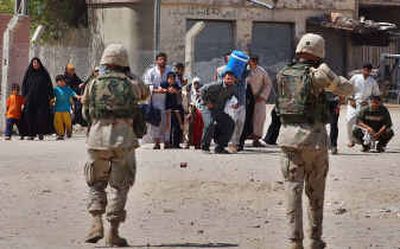Al-Sadr hurt in battle for Najaf

NAJAF, Iraq – Radical Shiite cleric Muqtada al-Sadr has been wounded during fighting between his followers and U.S. and Iraqi forces in the holy city of Najaf, Arab satellite television networks said today, quoting his aides.
Meanwhile, heavy fighting broke out in other cities in southern Iraq, and the country’s highest-ranking Shiite cleric called for an end to combat as U.S.-led troops fought to roust al-Sadr’s militia from the holiest city in Shiite Islam.
Al-Sadr is said to be holed up in Najaf’s sacred compound housing the Imam Ali shrine, surrounded by his followers. He has led an uprising against coalition troops for more than a week in the city, vowing to fight “until the last drop of my blood has been spilled.”
Aide Ahmed al-Shaibany said al-Sadr was wounded in three places during the clashes, Al-Jazeera reported, but didn’t say what happened or if the wounds were serious.
Another aide, Abdel Hadi al-Daraji, told al-Arabiya television that al-Sadr was hurt during shelling.
It wasn’t immediately possible to confirm the reports.
U.S. troops stormed al-Sadr’s house in Najaf on Thursday, only to find it empty, and launched a nighttime operation elsewhere in the area, accompanied by Iraqi commandos and U.S. Special Forces.
Shortly before dawn, the U.S. Army’s 7th Cavalry Regiment rumbled into Najaf, columns of M1-A1 Abrams tanks and Bradley Fighting Vehicles throwing up an armored cordon around the oldest section of the city. The encircled area extended in a roughly one-mile radius around the shrine of Imam Ali, which militiamen have occupied and used as a base for firing mortars. Grainy gun-sight images displayed by Iraqi officials in a Baghdad news conference showed the insurgents’ artillery teams inside the shrine complex.
The military offensive appeared to be deliberately paced, unfolding in stages that would allow Iraq’s political leadership to calibrate the pressure placed on insurgents who have controlled much of the city for at least the last week. A Marine spokesman, Lt. Col. T.V. Johnson, said combat had been “sporadic, and there have been no major engagements” with the militiamen.
In Baghdad, Interior Minister Falah Naqib said the country’s interim government “had no other solution” than to authorize the military operation. Naqib said efforts to broker a lasting peace deal with al-Sadr and involve his followers in Iraq’s interim government had failed.
“Previously, we had tried to solve all our problems politically and peacefully,” Naqib said. “What is happening at this stage is not to the benefit of anyone.”
Reports from other cities in Iraq’s predominantly Shiite south suggested a reprise of an uprising in April, when al-Sadr’s militia, the Mahdi Army, shocked the U.S.-led occupation authority and foreign troops by briefly taking power in several cities.
The fighting Thursday was most intense in Kufa, six miles east of Najaf. U.S. Special Forces called in an AC-130 gunship to destroy a Mahdi Army headquarters and a police station the militia had overrun. At one point, Iraqi security forces crossed the Tigris River in a small boat under machine gun fire to reclaim a vital bridge, according to the U.S. military. A commander with the Polish army, which is responsible for security in the area, called the situation serious and held out the possibility of requesting more U.S. troops.
Clashes involving Mahdi Army forces were also reported in Diwaniya and Nasiriya to the south of Najaf, as well as in Baghdad’s Sadr City, the vast Shiite slum named for al-Sadr’s late father, an esteemed ayatollah.
The military announced one American service member was killed in the day’s fighting but did not identify the victim or location.
Grand Ayatollah Ali Sistani, who left his Najaf home for the first time in six years just as clashes here began last week, finally broke his silence on Thursday, calling for an end to all fighting.
“All efforts should be directed to finding a peaceful solution,” Sistani said through an aide in London, where he is said to be receiving treatment for a heart condition. “A military solution will resolve nothing.”
U.S. commanders displayed confidence, while acknowledging the exceptional tactical challenge they face in trying to dislodge a guerrilla force from a religious site that U.S. troops are under orders not to target.
“They want the Americans to shoot the holy shrine,” a Najaf resident advised Army Maj. Doug Ollivant as the American mingled with Iraqis in the industrial section of the city. Relatively few in Najaf support al-Sadr, who they view as disrespectful of Sistani.
At the vast cemetery north of the shrine, Ollivant looked in on a company of the Army’s 1st Cavalry, 5th Regiment, which reinforced the Marine battalion there when the Mahdi Army ambushed it seven days earlier. That clash quickly escalated into a fight for control of sprawling necropolis of dun-colored tombs, which doubled as an arms depot and staging area for the militia.
A week later, the graveyard belonged to no one. The Americans patrolled to deny its use to the militia and draw their fire. A cavalry company called in helicopter fire on insurgents who fired mortars toward their position earlier in the day.
But the cavalry’s Bradley Fighting Vehicles ventured no closer than a mile from the southern border of the cemetery, which ends at the wall surrounding the Shrine of Imam Ali. Their barrels were pointed toward it, but they were forbidden to fire in that direction for fear of a shot reaching the sacred site and sending repercussions through the Muslim world.
“They’re using it as safe haven, and we’re being religious about not hitting the shrine,” Ollivant said. “It’s like Waco, only they’re holed up inside Saint Patrick’s Cathedral.”